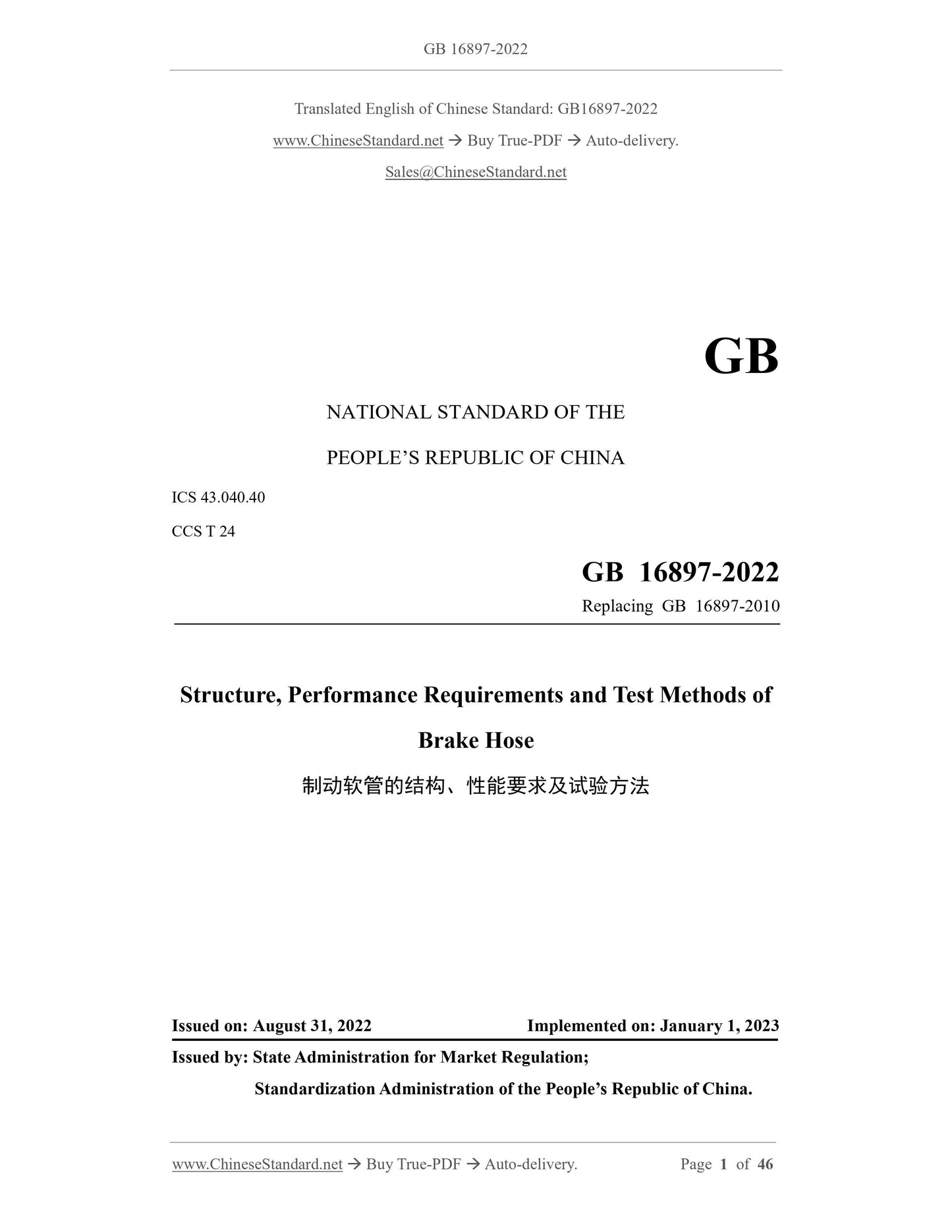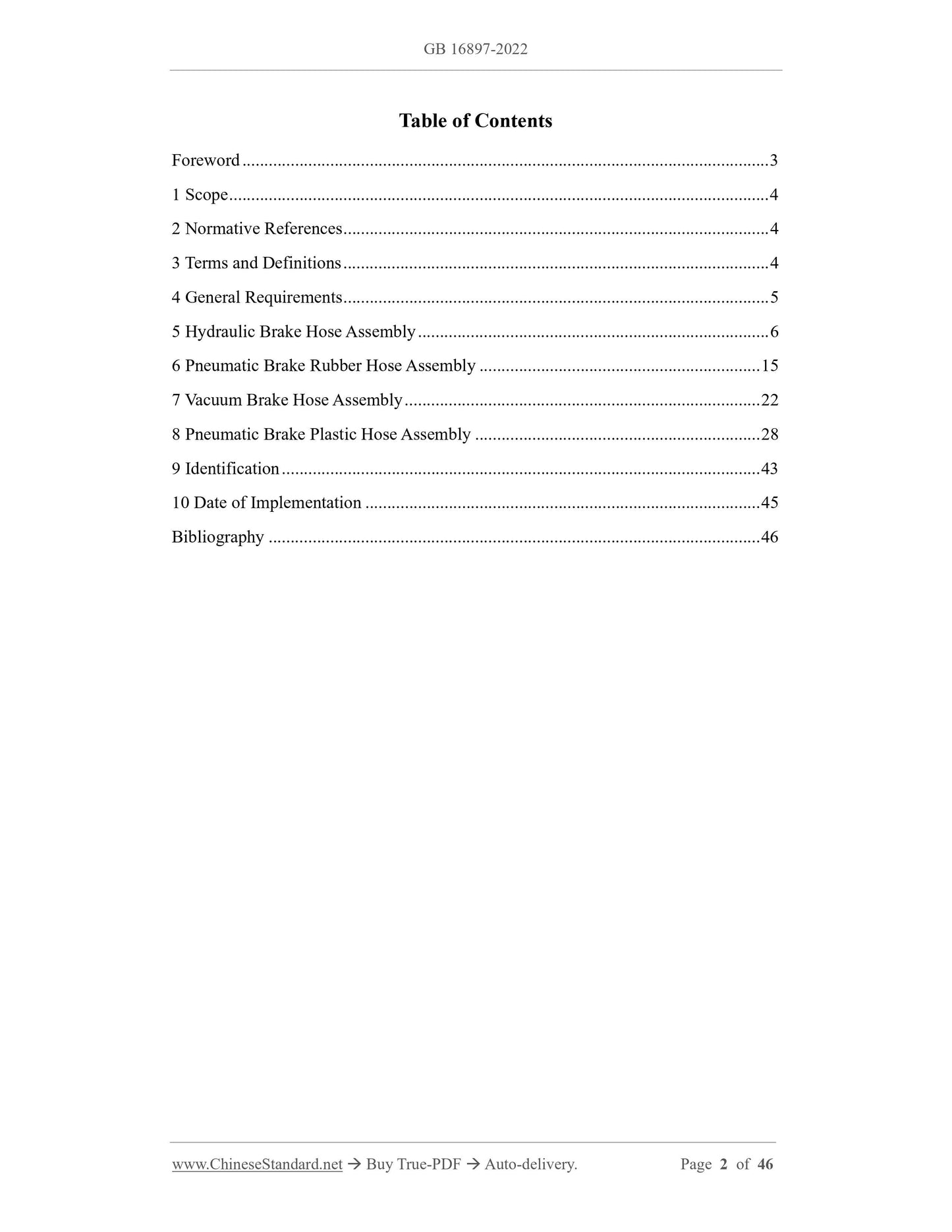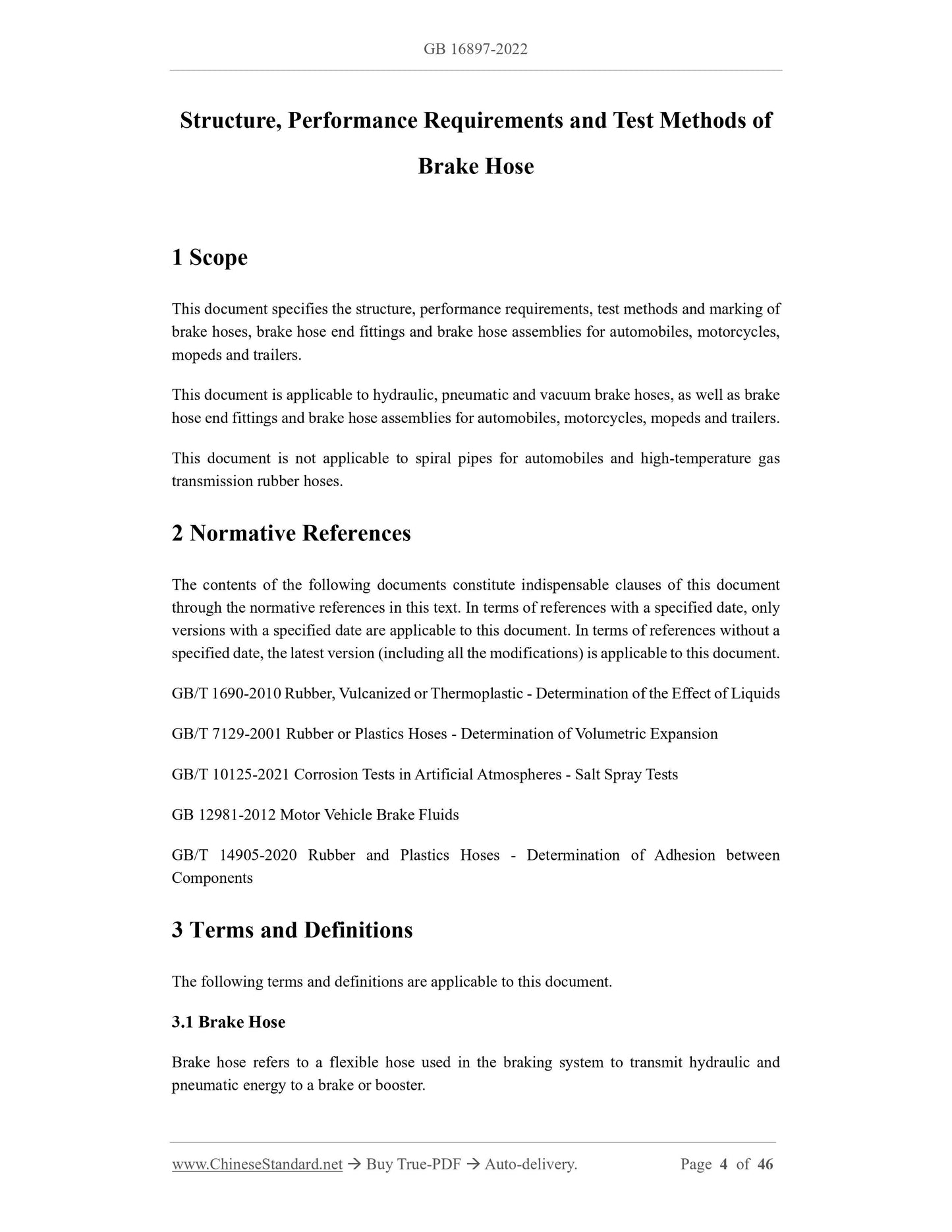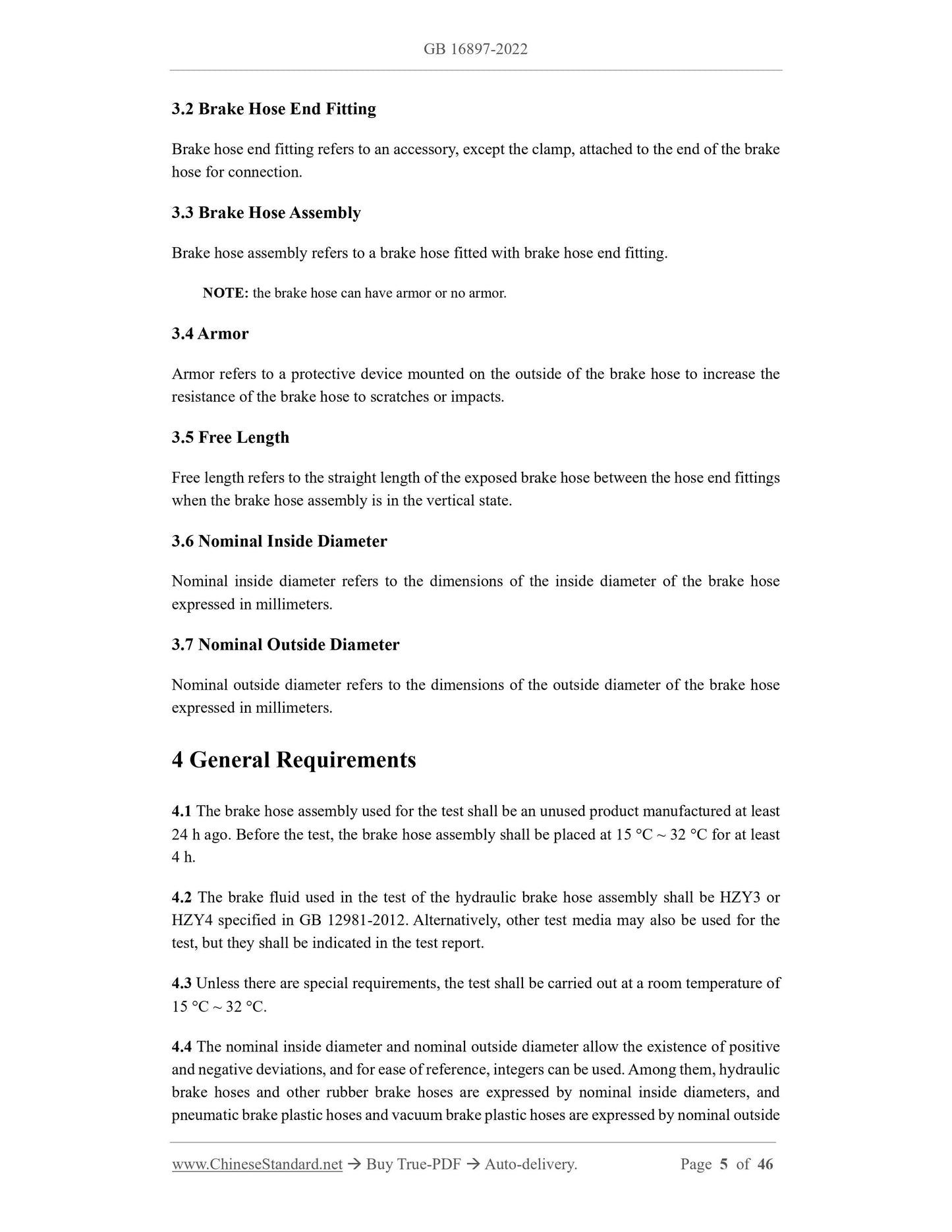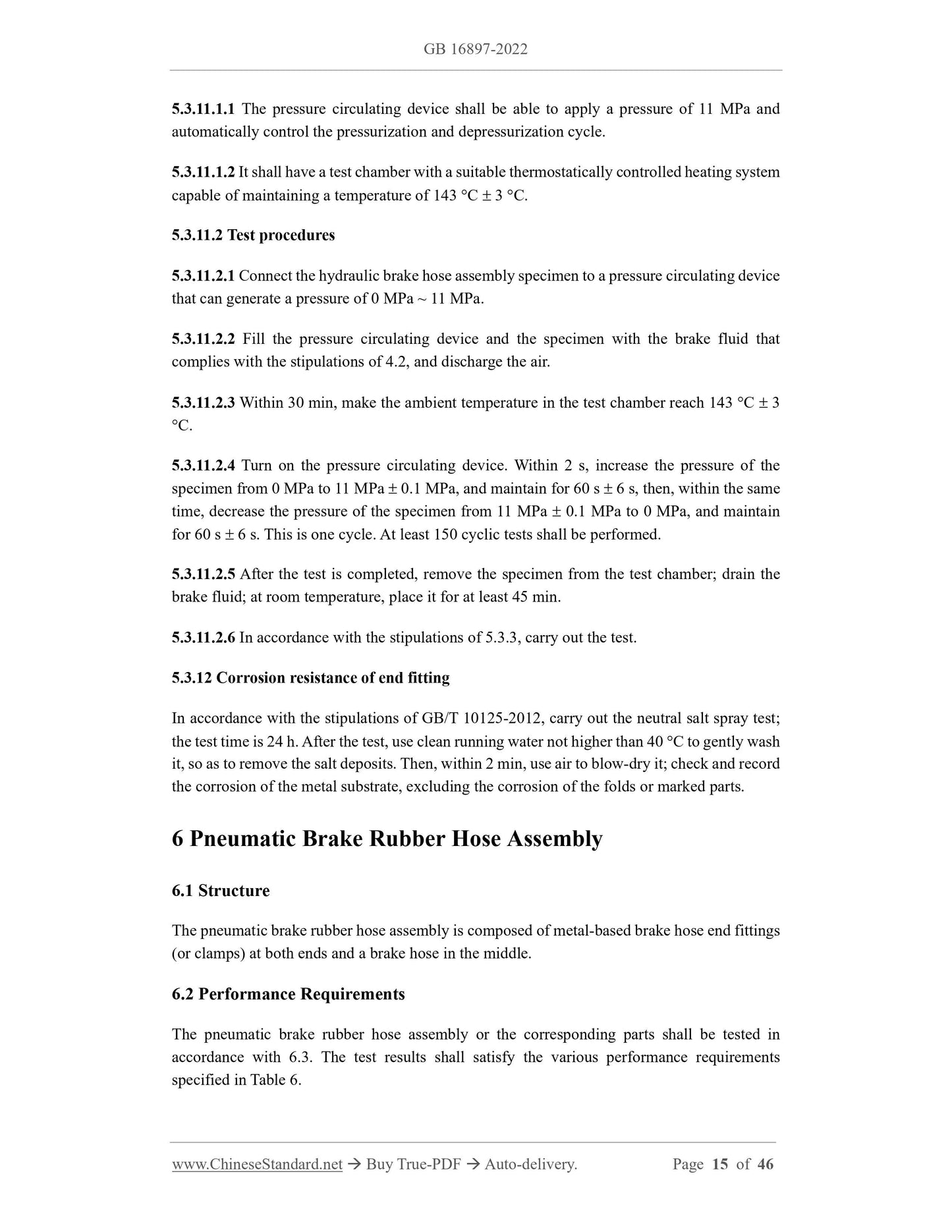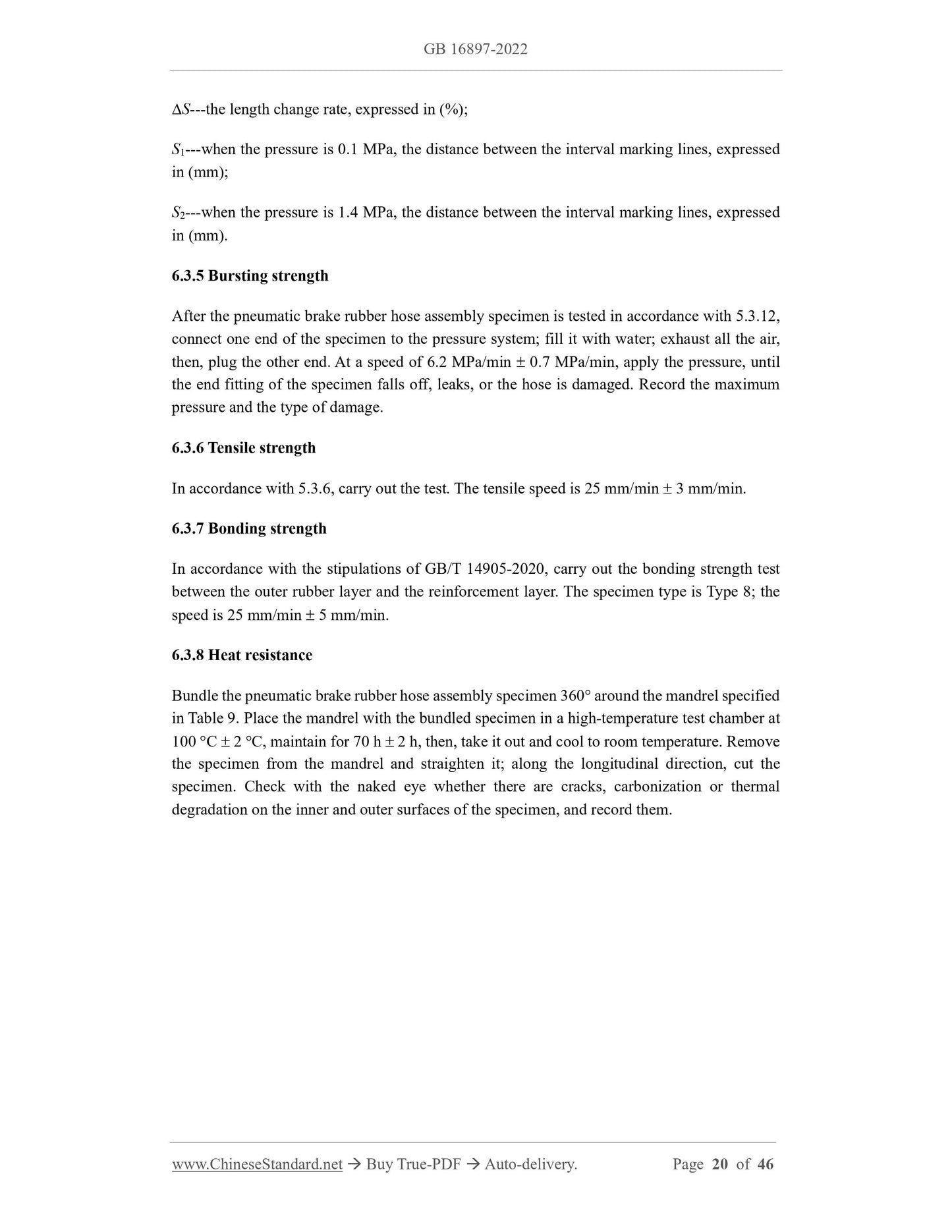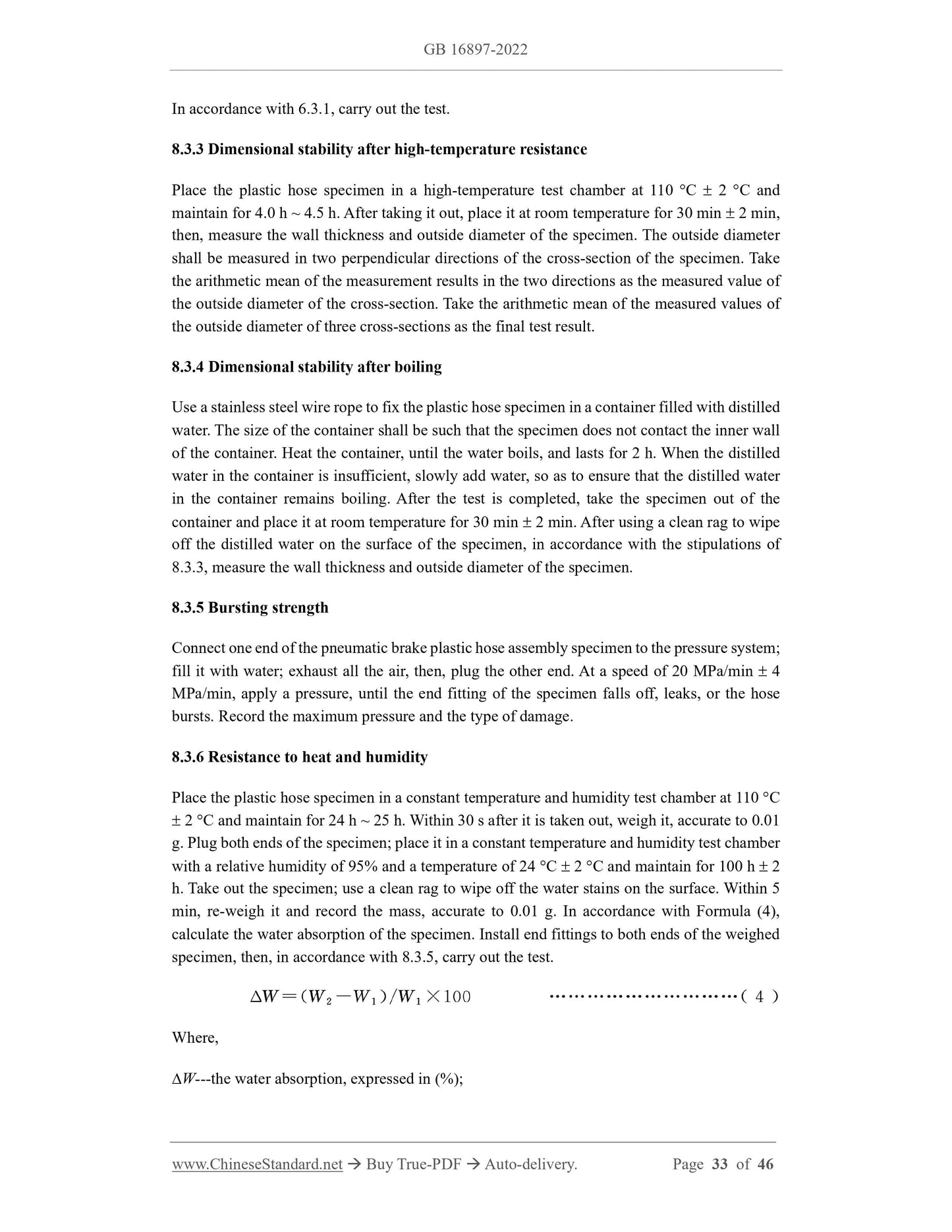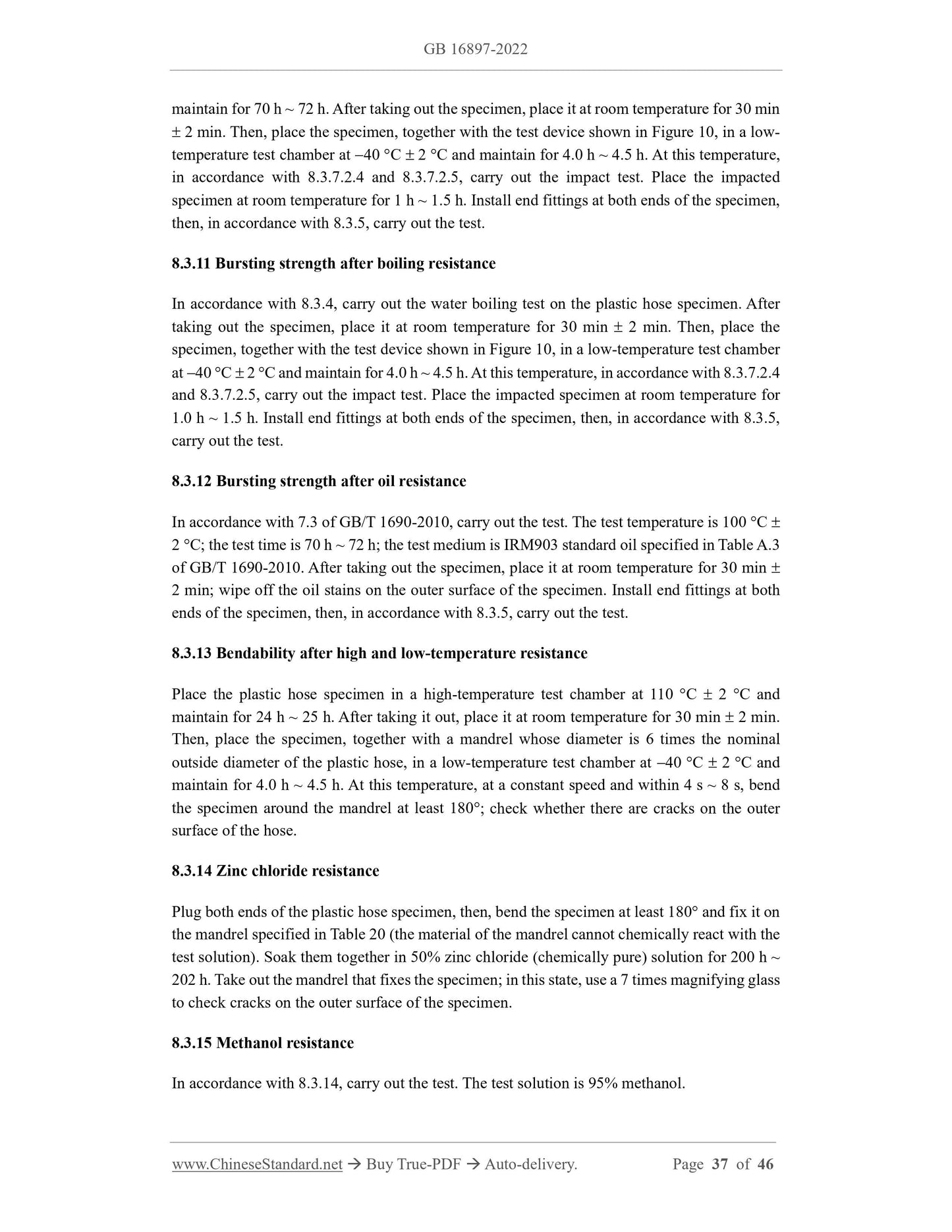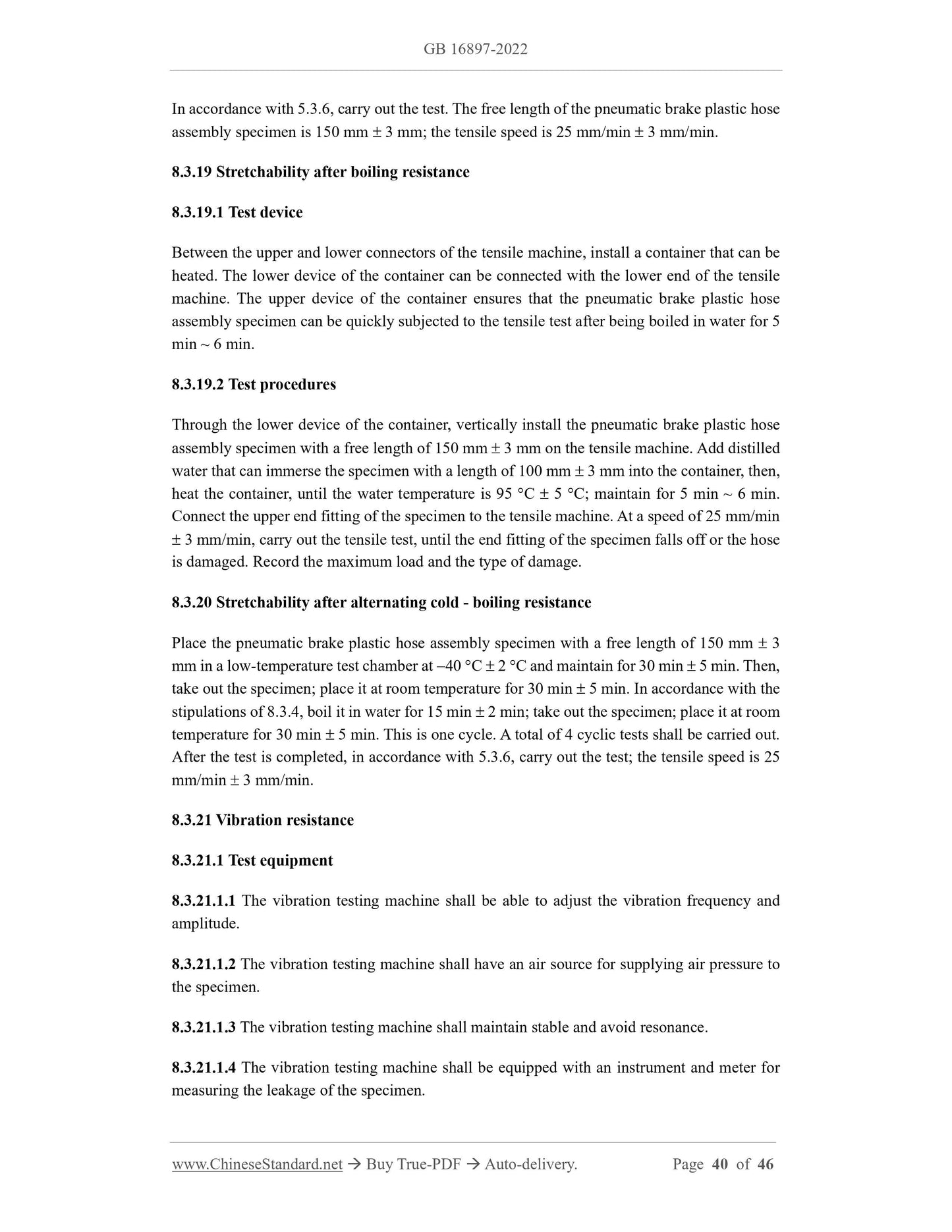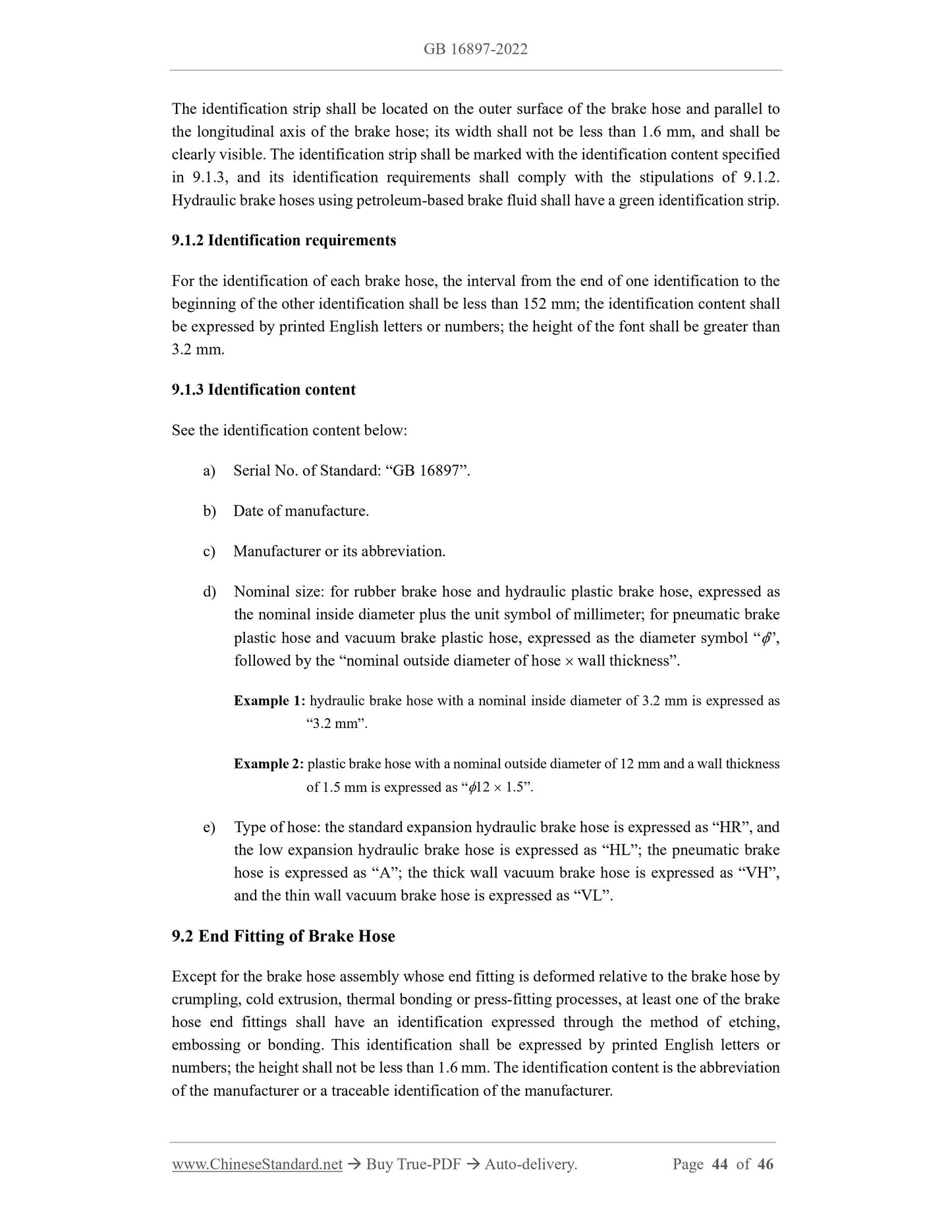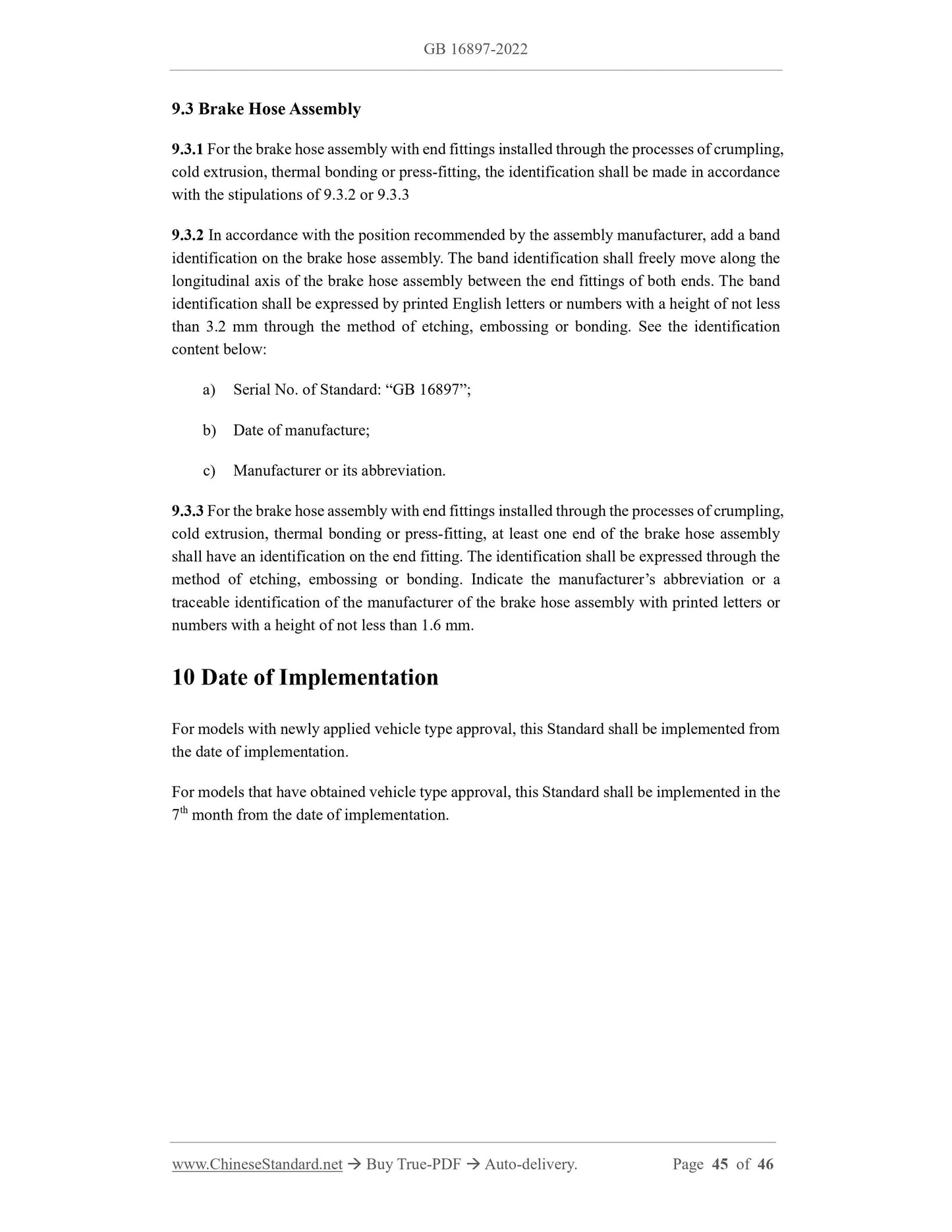1
/
dari
11
PayPal, credit cards. Download editable-PDF & invoice in 1 second!
GB 16897-2022 English PDF (GB16897-2022)
GB 16897-2022 English PDF (GB16897-2022)
Harga reguler
$500.00 USD
Harga reguler
Harga obral
$500.00 USD
Harga satuan
/
per
Biaya pengiriman dihitung saat checkout.
Tidak dapat memuat ketersediaan pengambilan
Delivery: 3 seconds. Download true-PDF + Invoice.
Get QUOTATION in 1-minute: Click GB 16897-2022
Historical versions: GB 16897-2022
Preview True-PDF (Reload/Scroll if blank)
GB 16897-2022: Structure, performance requirements and test methods of brake hose
GB 16897-2022
GB
NATIONAL STANDARD OF THE
PEOPLE’S REPUBLIC OF CHINA
ICS 43.040.40
CCS T 24
Replacing GB 16897-2010
Structure, Performance Requirements and Test Methods of
Brake Hose
ISSUED ON: AUGUST 31, 2022
IMPLEMENTED ON: JANUARY 1, 2023
Issued by: State Administration for Market Regulation;
Standardization Administration of the People’s Republic of China.
Table of Contents
Foreword ... 3
1 Scope ... 4
2 Normative References ... 4
3 Terms and Definitions ... 4
4 General Requirements ... 5
5 Hydraulic Brake Hose Assembly ... 6
6 Pneumatic Brake Rubber Hose Assembly ... 15
7 Vacuum Brake Hose Assembly ... 22
8 Pneumatic Brake Plastic Hose Assembly ... 28
9 Identification ... 43
10 Date of Implementation ... 45
Bibliography ... 46
Structure, Performance Requirements and Test Methods of
Brake Hose
1 Scope
This document specifies the structure, performance requirements, test methods and marking of
brake hoses, brake hose end fittings and brake hose assemblies for automobiles, motorcycles,
mopeds and trailers.
This document is applicable to hydraulic, pneumatic and vacuum brake hoses, as well as brake
hose end fittings and brake hose assemblies for automobiles, motorcycles, mopeds and trailers.
This document is not applicable to spiral pipes for automobiles and high-temperature gas
transmission rubber hoses.
2 Normative References
The contents of the following documents constitute indispensable clauses of this document
through the normative references in this text. In terms of references with a specified date, only
versions with a specified date are applicable to this document. In terms of references without a
specified date, the latest version (including all the modifications) is applicable to this document.
GB/T 1690-2010 Rubber, Vulcanized or Thermoplastic - Determination of the Effect of Liquids
GB/T 7129-2001 Rubber or Plastics Hoses - Determination of Volumetric Expansion
GB/T 10125-2021 Corrosion Tests in Artificial Atmospheres - Salt Spray Tests
GB 12981-2012 Motor Vehicle Brake Fluids
GB/T 14905-2020 Rubber and Plastics Hoses - Determination of Adhesion between
Components
3 Terms and Definitions
The following terms and definitions are applicable to this document.
3.1 Brake Hose
Brake hose refers to a flexible hose used in the braking system to transmit hydraulic and
pneumatic energy to a brake or booster.
3.2 Brake Hose End Fitting
Brake hose end fitting refers to an accessory, except the clamp, attached to the end of the brake
hose for connection.
3.3 Brake Hose Assembly
Brake hose assembly refers to a brake hose fitted with brake hose end fitting.
NOTE: the brake hose can have armor or no armor.
3.4 Armor
Armor refers to a protective device mounted on the outside of the brake hose to increase the
resistance of the brake hose to scratches or impacts.
3.5 Free Length
Free length refers to the straight length of the exposed brake hose between the hose end fittings
when the brake hose assembly is in the vertical state.
3.6 Nominal Inside Diameter
Nominal inside diameter refers to the dimensions of the inside diameter of the brake hose
expressed in millimeters.
3.7 Nominal Outside Diameter
Nominal outside diameter refers to the dimensions of the outside diameter of the brake hose
expressed in millimeters.
4 General Requirements
4.1 The brake hose assembly used for the test shall be an unused product manufactured at least
24 h ago. Before the test, the brake hose assembly shall be placed at 15 C ~ 32 C for at least
4 h.
4.2 The brake fluid used in the test of the hydraulic brake hose assembly shall be HZY3 or
HZY4 specified in GB 12981-2012. Alternatively, other test media may also be used for the
test, but they shall be indicated in the test report.
4.3 Unless there are special requirements, the test shall be carried out at a room temperature of
15 C ~ 32 C.
4.4 The nominal inside diameter and nominal outside diameter allow the existence of positive
and negative deviations, and for ease of reference, integers can be used. Among them, hydraulic
brake hoses and other rubber brake hoses are expressed by nominal inside diameters, and
pneumatic brake plastic hoses and vacuum brake plastic hoses are expressed by nominal outside
5.3.11.1.1 The pressure circulating device shall be able to apply a pressure of 11 MPa and
automatically control the pressurization and depressurization cycle.
5.3.11.1.2 It shall have a test chamber with a suitable thermostatically controlled heating system
capable of maintaining a temperature of 143 C 3 C.
5.3.11.2 Test procedures
5.3.11.2.1 Connect the hydraulic brake hose assembly specimen to a pressure circulating device
that can generate a pressure of 0 MPa ~ 11 MPa.
5.3.11.2.2 Fill the pressure circulating device and the specimen with the brake fluid that
complies with the stipulations of 4.2, and discharge the air.
5.3.11.2.3 Within 30 min, make the ambient temperature in the test chamber reach 143 C 3
C.
5.3.11.2.4 Turn on the pressure circulating device. Within 2 s, increase the pressure of the
specimen from 0 MPa to 11 MPa 0.1 MPa, and maintain for 60 s 6 s, then, within the same
time, decrease the pressure of the specimen from 11 MPa 0.1 MPa to 0 MPa, and maintain
for 60 s 6 s. This is one cycle. At least 150 cyclic tests shall be performed.
5.3.11.2.5 After the test is completed, remove the specimen from the test chamber; drain the
brake fluid; at room temperature, place it for at least 45 min.
5.3.11.2.6 In accordance with the stipulations of 5.3.3, carry out the test.
5.3.12 Corrosion resistance of end fitting
In accordance with the stipulations of GB/T 10125-2012, carry out the neutral salt spray test;
the test time is 24 h. After the test, use clean running water not higher than 40 C to gently wash
it, so as to remove the salt deposits. Then, within 2 min, use air to blow-dry it; check and record
the corrosion of the metal substrate, excluding the corrosion of the folds or marked parts.
6 Pneumatic Brake Rubber Hose Assembly
6.1 Structure
The pneumatic brake rubber hose assembly is composed of metal-based brake hose end fittings
(or clamps) at both ends and a brake hose in the middle.
6.2 Performance Requirements
The pneumatic brake rubber hose assembly or the corresponding parts shall be tested in
accordance with 6.3. The test results shall satisfy the various performance requirements
specified in Table 6.
S---the length change rate, expressed in (%);
S1---when the pressure is 0.1 MPa, the distance between the interval marking lines, expressed
in (mm);
S2---when the pressure is 1.4 MPa, the distance between the interval marking lines, expressed
in (mm).
6.3.5 Bursting strength
After the pneumatic brake rubber hose assembly specimen is tested in accordance with 5.3.12,
connect one end of the specimen to the pressure system; fill it with water; exhaust all the air,
then, plug the other end. At a speed of 6.2 MPa/min 0.7 MPa/min, apply the pressure, until
the end fitting of the specimen falls off, leaks, or the hose is damaged. Record the maximum
pressure and the type of damage.
6.3.6 Tensile strength
In accordance with 5.3.6, carry out the test. The tensile speed is 25 mm/min 3 mm/min.
6.3.7 Bonding strength
In accordance with the stipulations of GB/T 14905-2020, carry out the bonding strength test
between the outer rubber layer and the rein...
Get QUOTATION in 1-minute: Click GB 16897-2022
Historical versions: GB 16897-2022
Preview True-PDF (Reload/Scroll if blank)
GB 16897-2022: Structure, performance requirements and test methods of brake hose
GB 16897-2022
GB
NATIONAL STANDARD OF THE
PEOPLE’S REPUBLIC OF CHINA
ICS 43.040.40
CCS T 24
Replacing GB 16897-2010
Structure, Performance Requirements and Test Methods of
Brake Hose
ISSUED ON: AUGUST 31, 2022
IMPLEMENTED ON: JANUARY 1, 2023
Issued by: State Administration for Market Regulation;
Standardization Administration of the People’s Republic of China.
Table of Contents
Foreword ... 3
1 Scope ... 4
2 Normative References ... 4
3 Terms and Definitions ... 4
4 General Requirements ... 5
5 Hydraulic Brake Hose Assembly ... 6
6 Pneumatic Brake Rubber Hose Assembly ... 15
7 Vacuum Brake Hose Assembly ... 22
8 Pneumatic Brake Plastic Hose Assembly ... 28
9 Identification ... 43
10 Date of Implementation ... 45
Bibliography ... 46
Structure, Performance Requirements and Test Methods of
Brake Hose
1 Scope
This document specifies the structure, performance requirements, test methods and marking of
brake hoses, brake hose end fittings and brake hose assemblies for automobiles, motorcycles,
mopeds and trailers.
This document is applicable to hydraulic, pneumatic and vacuum brake hoses, as well as brake
hose end fittings and brake hose assemblies for automobiles, motorcycles, mopeds and trailers.
This document is not applicable to spiral pipes for automobiles and high-temperature gas
transmission rubber hoses.
2 Normative References
The contents of the following documents constitute indispensable clauses of this document
through the normative references in this text. In terms of references with a specified date, only
versions with a specified date are applicable to this document. In terms of references without a
specified date, the latest version (including all the modifications) is applicable to this document.
GB/T 1690-2010 Rubber, Vulcanized or Thermoplastic - Determination of the Effect of Liquids
GB/T 7129-2001 Rubber or Plastics Hoses - Determination of Volumetric Expansion
GB/T 10125-2021 Corrosion Tests in Artificial Atmospheres - Salt Spray Tests
GB 12981-2012 Motor Vehicle Brake Fluids
GB/T 14905-2020 Rubber and Plastics Hoses - Determination of Adhesion between
Components
3 Terms and Definitions
The following terms and definitions are applicable to this document.
3.1 Brake Hose
Brake hose refers to a flexible hose used in the braking system to transmit hydraulic and
pneumatic energy to a brake or booster.
3.2 Brake Hose End Fitting
Brake hose end fitting refers to an accessory, except the clamp, attached to the end of the brake
hose for connection.
3.3 Brake Hose Assembly
Brake hose assembly refers to a brake hose fitted with brake hose end fitting.
NOTE: the brake hose can have armor or no armor.
3.4 Armor
Armor refers to a protective device mounted on the outside of the brake hose to increase the
resistance of the brake hose to scratches or impacts.
3.5 Free Length
Free length refers to the straight length of the exposed brake hose between the hose end fittings
when the brake hose assembly is in the vertical state.
3.6 Nominal Inside Diameter
Nominal inside diameter refers to the dimensions of the inside diameter of the brake hose
expressed in millimeters.
3.7 Nominal Outside Diameter
Nominal outside diameter refers to the dimensions of the outside diameter of the brake hose
expressed in millimeters.
4 General Requirements
4.1 The brake hose assembly used for the test shall be an unused product manufactured at least
24 h ago. Before the test, the brake hose assembly shall be placed at 15 C ~ 32 C for at least
4 h.
4.2 The brake fluid used in the test of the hydraulic brake hose assembly shall be HZY3 or
HZY4 specified in GB 12981-2012. Alternatively, other test media may also be used for the
test, but they shall be indicated in the test report.
4.3 Unless there are special requirements, the test shall be carried out at a room temperature of
15 C ~ 32 C.
4.4 The nominal inside diameter and nominal outside diameter allow the existence of positive
and negative deviations, and for ease of reference, integers can be used. Among them, hydraulic
brake hoses and other rubber brake hoses are expressed by nominal inside diameters, and
pneumatic brake plastic hoses and vacuum brake plastic hoses are expressed by nominal outside
5.3.11.1.1 The pressure circulating device shall be able to apply a pressure of 11 MPa and
automatically control the pressurization and depressurization cycle.
5.3.11.1.2 It shall have a test chamber with a suitable thermostatically controlled heating system
capable of maintaining a temperature of 143 C 3 C.
5.3.11.2 Test procedures
5.3.11.2.1 Connect the hydraulic brake hose assembly specimen to a pressure circulating device
that can generate a pressure of 0 MPa ~ 11 MPa.
5.3.11.2.2 Fill the pressure circulating device and the specimen with the brake fluid that
complies with the stipulations of 4.2, and discharge the air.
5.3.11.2.3 Within 30 min, make the ambient temperature in the test chamber reach 143 C 3
C.
5.3.11.2.4 Turn on the pressure circulating device. Within 2 s, increase the pressure of the
specimen from 0 MPa to 11 MPa 0.1 MPa, and maintain for 60 s 6 s, then, within the same
time, decrease the pressure of the specimen from 11 MPa 0.1 MPa to 0 MPa, and maintain
for 60 s 6 s. This is one cycle. At least 150 cyclic tests shall be performed.
5.3.11.2.5 After the test is completed, remove the specimen from the test chamber; drain the
brake fluid; at room temperature, place it for at least 45 min.
5.3.11.2.6 In accordance with the stipulations of 5.3.3, carry out the test.
5.3.12 Corrosion resistance of end fitting
In accordance with the stipulations of GB/T 10125-2012, carry out the neutral salt spray test;
the test time is 24 h. After the test, use clean running water not higher than 40 C to gently wash
it, so as to remove the salt deposits. Then, within 2 min, use air to blow-dry it; check and record
the corrosion of the metal substrate, excluding the corrosion of the folds or marked parts.
6 Pneumatic Brake Rubber Hose Assembly
6.1 Structure
The pneumatic brake rubber hose assembly is composed of metal-based brake hose end fittings
(or clamps) at both ends and a brake hose in the middle.
6.2 Performance Requirements
The pneumatic brake rubber hose assembly or the corresponding parts shall be tested in
accordance with 6.3. The test results shall satisfy the various performance requirements
specified in Table 6.
S---the length change rate, expressed in (%);
S1---when the pressure is 0.1 MPa, the distance between the interval marking lines, expressed
in (mm);
S2---when the pressure is 1.4 MPa, the distance between the interval marking lines, expressed
in (mm).
6.3.5 Bursting strength
After the pneumatic brake rubber hose assembly specimen is tested in accordance with 5.3.12,
connect one end of the specimen to the pressure system; fill it with water; exhaust all the air,
then, plug the other end. At a speed of 6.2 MPa/min 0.7 MPa/min, apply the pressure, until
the end fitting of the specimen falls off, leaks, or the hose is damaged. Record the maximum
pressure and the type of damage.
6.3.6 Tensile strength
In accordance with 5.3.6, carry out the test. The tensile speed is 25 mm/min 3 mm/min.
6.3.7 Bonding strength
In accordance with the stipulations of GB/T 14905-2020, carry out the bonding strength test
between the outer rubber layer and the rein...
Share
